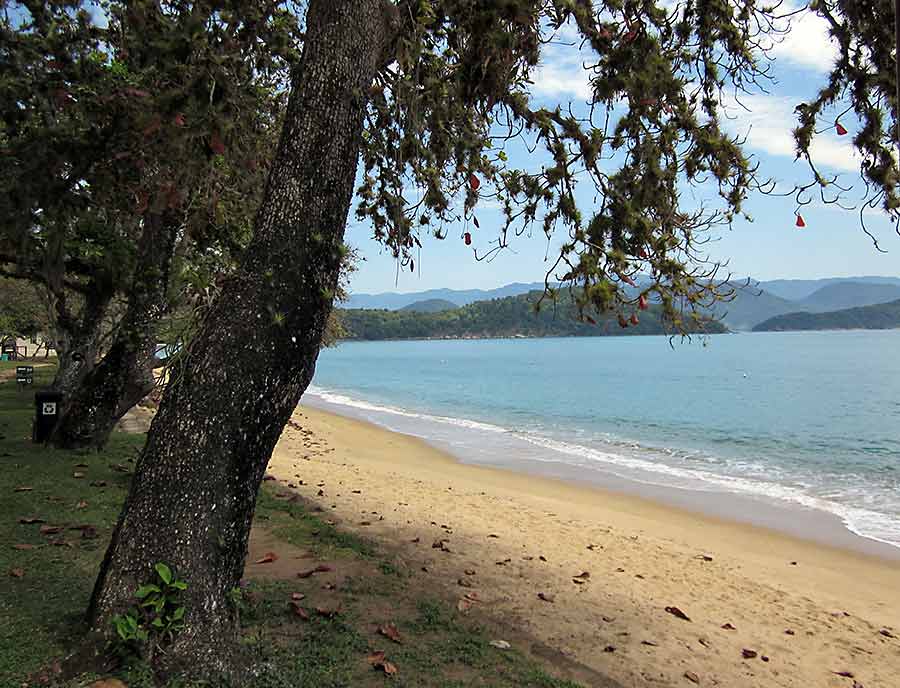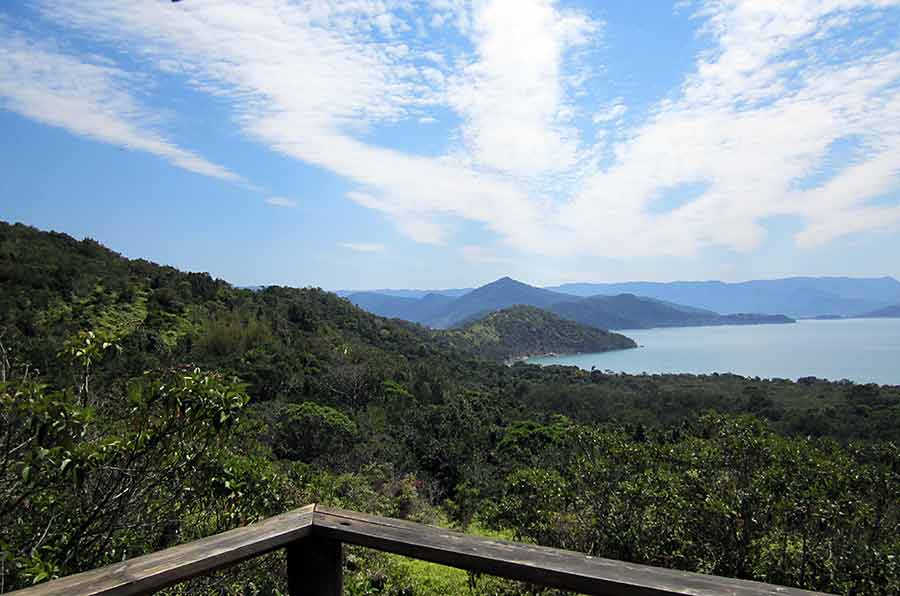Ilhabela

Mystic of Holyhead (successor to Lynn Rival)
Rachel and Paul Chandler
Sun 22 Sep 2013 23:14
|
23:47.05S 045:21.63W The weather forecast looked OK so we got up early - a challenge for us! - and set off at dawn from Mamangua. Our intended destination was Ilha Anchieta, some 45 miles away. We had the gennaker at the ready, in anticipation of light winds aft of the beam. Once out in the open sea we hoisted it and switched off the motor. We struggled along at a snail's pace, being rolled around by the familiar south Atlantic swell with the sail flapping, until we gave up and burned some more diesel. A couple of hours later we went through the same routine when the wind picked up for a brief spell - but again we soon had to give up. Eventually we motored into Enseada das Palmas, a big bay on the north of Ilha Anchieta (aka Ilha dos Porcos) in the late afternoon. The best shelter looked to be on the east side of the bay so we dropped anchor off a small beach where a few Sunday afternoon visitors were anchored, enjoying the lovely spot with a spring water shower and natural rock swimming pool nearby. By nightfall we had the place to ourselves.  Lynn Rival at anchor, Ilha Anchieta  The central beach, Baia das Palmas (the palms are not on this beach), Ilha Anchietta  Looking across towards the mainland from a thoughtfully provided 'mirante' or viewpoint Ilha Anchieta was once a penal colony and is now a nature reserve. Over the years the island was stripped of it's forest and the wildlife hunted to near extinction. Now the rainforest has been allowed to re-establish itself and wildlife encouraged to flourish. A big rodent called the Capivara has been introduced - why? To trim the 'lawns' according to the translation on the local signs! On Monday the weather was fine so we rowed ashore and had a pleasant walk around the ruins of the prison and along a trail through the forest to a little beach on the south of the island. We didn't see any Capivara, only their droppings. Back on board Lynn Rival we were hailed by a passing yachtsman, who invited us to come to the nearby mainland and have lunch at his house in Ubatuba. We explained that we were waiting for the winds to improve so we could sail on south. After a couple of days of cloud and rain, the forecast remained against us so on Thursday we motored over to Saco do Ribeira, where our new friend, Tio, had arranged a mooring for us. Not only did Tio's wife, Cecilia, cook us a really nice fish lunch but she also did our laundry while Tio took us shopping for provisions! Unfortunately the weather was very overcast so we couldn't appreciate the wonderful views of the coastline for which Ubatuba is famous but Tio did show us the place where the Tropic of Capricorn is marked. Yet again we're reminded of how far south we are. Moving into the sub-tropics means that we are even more at the mercy of the South Atlantic lows that start inland north of the River Plate and head east, with long frontal systems reaching north west, bringing stormy weather and southerly winds. This part of the coastline, between Rio and Florianopolis, is renowned for the light and fickle winds we've been experiencing, plus rain and strong southerlies in the winter (May-September) when the fronts pass over. If it weren't for our visas running out we'd wait until November. As it is we'll just have to be patient and pick our moment to move on to the next stopover. Some people say not to worry about our visas because the authorities don't bother checking leisure yachts but we're not prepared to take the risk of having Lynn Rival impounded! On Friday the forecast looked good for a short 20 mile trip south to Ilhabela (properly known as Ilha de Sao Sebastiao): light winds from the east. We said goodbye to our friends and set off. The forecast got it all wrong and we motored into headwinds, locally over 20 knots against us in the channel separating Ilhabela from the mainland. On the advice of friends in Bracuhy we picked up a mooring off the Pinda Yacht Club, just south of the old town of Ilhabela, now called Vila ("Town"). Within minutes the club launch picked us up and took us ashore to fill in the visitors' book and then back to show us which mooring to use. Our arrival could not have been made easier.  Pinda Iate Clube, with handy secure pontoon to leave the dinghy - and a launch service during daylight Ilhabela is the largest oceanic island of Brazil with many beautiful beaches. It's big on tourism, sailing, diving and surfing, etc. but it's also managed to retain much of it's rainforest. (Most of the island is a protected wildlife park.) On Saturday morning the sun was shining so we rowed ashore and made our way along the beach to the tourist office. There are a few trails into the forest, starting from various points on the island. Most are only a few kilometres walk up to a waterfall, but some are more serious. Unlike Ilha Grande, the island does have roads, notably one main road that runs all the way along the west coast, with a regular bus service. We caught a bus southwest to Sao Pedro for a "medium" 2km walk up to the Veloso waterfall. The start of the trail isn't well sign-posted so we ended up walking the wrong way uphill for a kilometre but eventually realised our mistake and found our way into dense forest, with the sounds of birds all around us. An informative sign at the start of the walk included a picture of a snake so we were too busy looking down at our feet to notice many birds! The waterfall was lovely and we managed to keep the borrachudos* at bay with an ample covering of deet on exposed flesh.  We had to learn to recognise these 15 birds. Rachel spotted number 10, the red-head!  At the falls we refilled water bottles and applied more deet for the return trek *Borrachudos are tiny black flies that bite, producing a spot that itches like mad for days - worse than a Greek mosquito. They are a hazard for walkers in the rainforest but don't seem to affect the beach-lovers. |